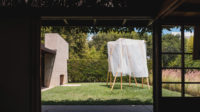Storefront Celebrates 25 Years
Manhattan’s Storefront for Art and Architecture celebrates its 25th birthday this month and the gallery is breaking out hula hoops to celebrate. Over the coming weeks, the non-profit gallery will host a series of public events in “Ring Dome,” a temporary pavilion, designed by Korean architect Minsuk Cho of Seoul-based Mass Studies, made of 1,000 off-the-shelf plastic hoops stuffed with electroluminescent wire.

The Storefront for Art and Architecture celebrates its 25th birthday this month with “Ring Dome,” a temporary pavilion designed by Korean architect Minsuk Cho of Seoul-based Mass Studies. The sculpture is made of 1,000 off-the-shelf plastic hoops stuffed with electroluminescent wire. It is located in Petrosino Park, a busy traffic island just west of the Storefront’s permanent gallery in Manhattan.
Situated in Petrosino Park, a busy traffic island at the intersection of Kenmare and Lafayette streets near Storefront’s permanent gallery, the pavilion’s prominent placement and open framework is intended to be a reflection of the storied gallery’s mission. “It’s important to be operating in a public space that’s freely accessible,” says Storefront director Joseph Grima. “As well as bringing a great number of topics into our exhibition program, Storefront’s role today is to bring people together—from as diverse a community as possible—to discuss pressing issues.”
Since it opened in 1982, the gallery has exhibited the work of more than a thousand artists and architects, frequently blurring the line between art and architecture, helping to foster more provocative architecture exhibitions elsewhere.
“Although its point of departure was the art world, Storefront was one of the first galleries to operate inclusively toward architecture and to cross the boundary into the world of the built environment and architectural thinking,” Grima says. “It was a place for the most experimental ideas in architecture.”
Starting tomorrow evening, September 21, Ring Dome will host “Performance Z-A,” a series of individual events over 26 consecutive days involving artists, architects, speakers, and musicians including Vito Acconci, Bjarke Ingels of BIG, Stefano Boeri, Marilyn Minter, and Dan Graham. All events start at 7 p.m. and a full schedule is available at www.storefrontnews.org. It is an updated take on Storefront’s first public event series 25 years ago, which was titled “Performance A-Z.”
“With Performance A-Z, it was only performance art,” Grima says. “This time, it’s many different events, from film screenings to discussions to book launches to concerts to architectural lectures to DJ sets. That reflects the diversity of influences at play in architecture today.”
Moving the festivities beyond Storefront’s famous multi-paneled facade, which was designed by Steven Holl and Vito Acconci in 1993, also communicates another important point. “The facade has become a synonym of Storefront, but Storefront is not a building or a particular space,” Grima says. “It actually existed 10 years before that facade. Storefront is an idea.”




